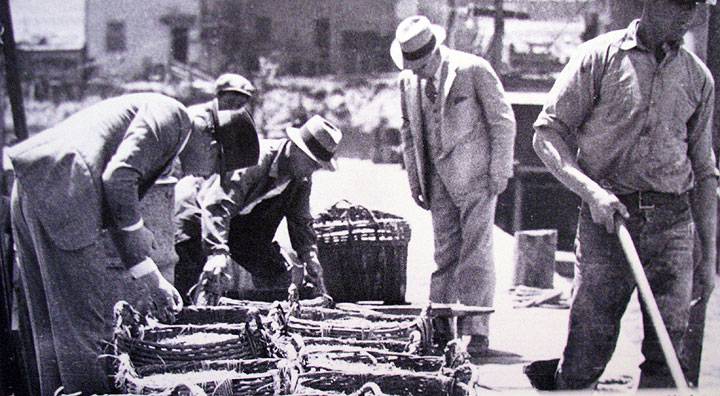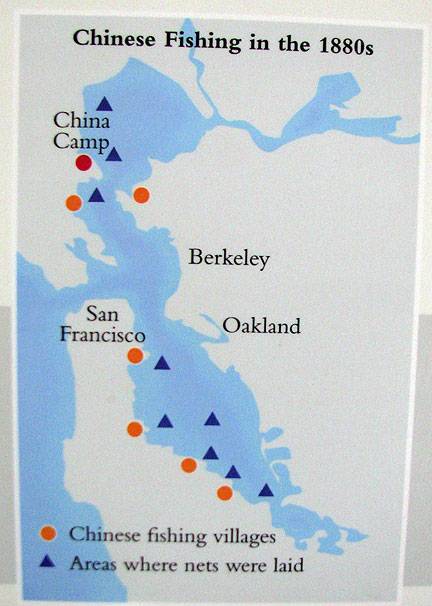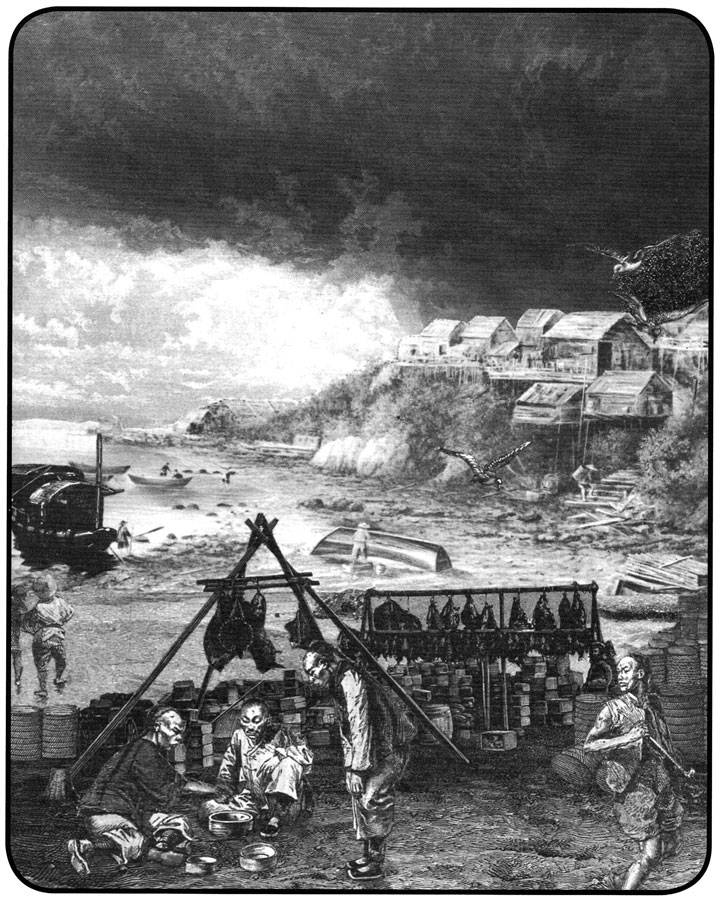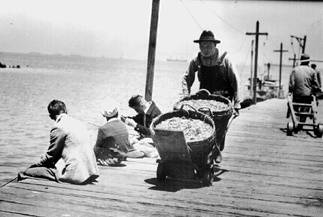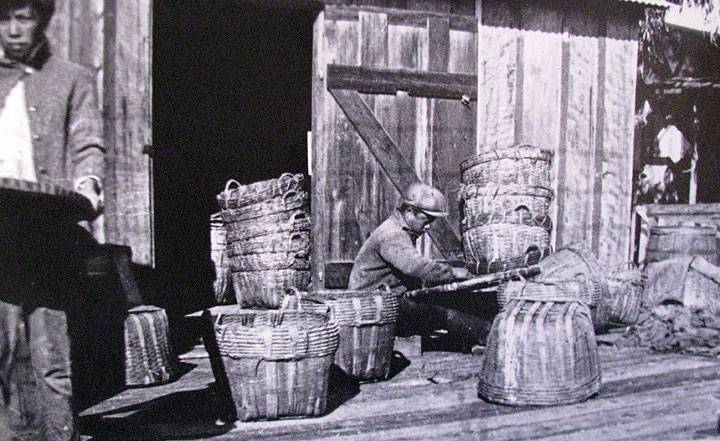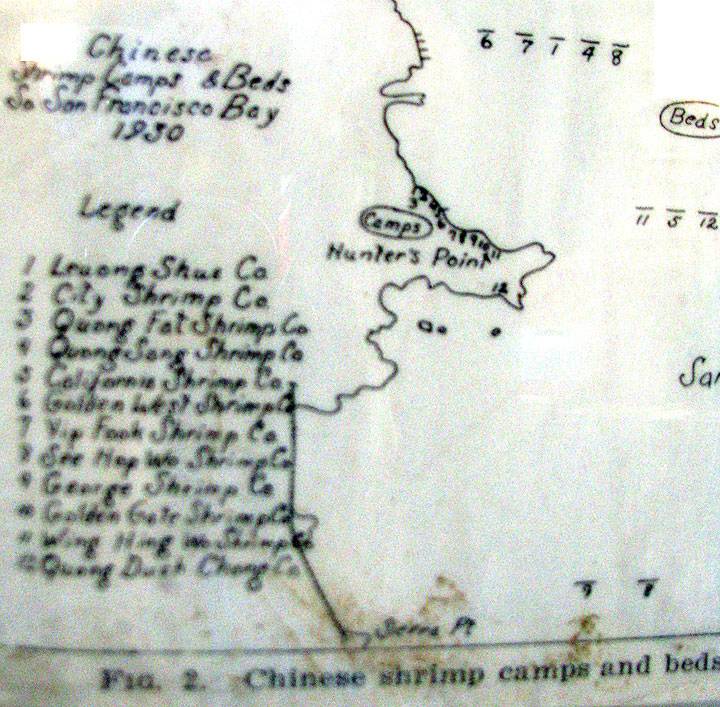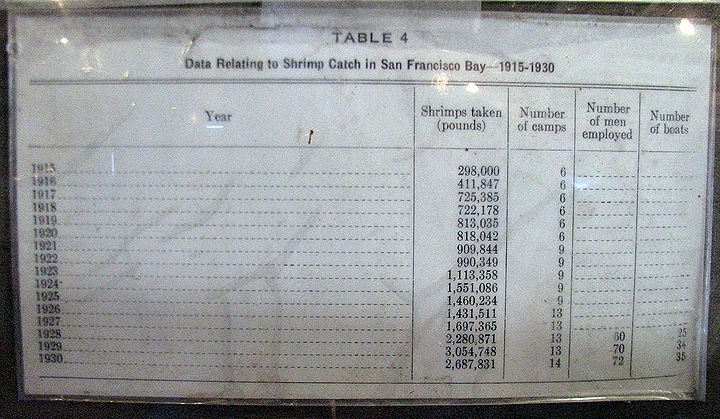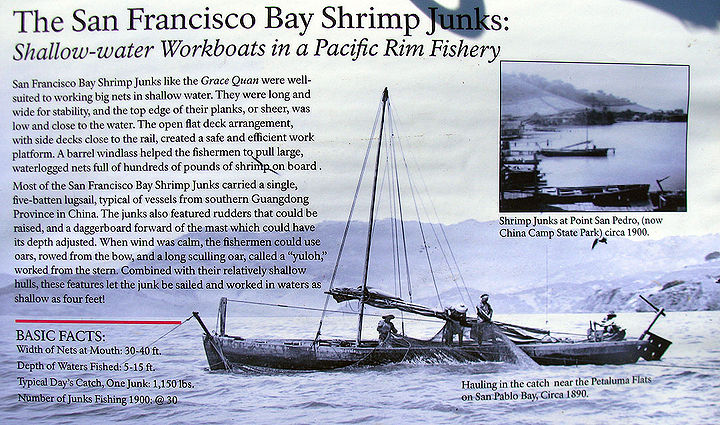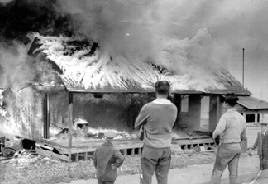Chinese shrimping village: Difference between revisions
(new food tour link) |
m (changed images to "private collection") |
||
| (5 intermediate revisions by 2 users not shown) | |||
| Line 1: | Line 1: | ||
'''<font face = arial light> <font color = maroon> <font size = 3>Unfinished History</font></font> </font>''' | '''<font face = arial light> <font color = maroon> <font size = 3>Unfinished History</font></font> </font>''' | ||
[[Image:White-buyers-at-HP-shrimp-dock 2837.jpg]] | |||
'''White buyers peruse fresh shrimp on sale at the docks along India Basin in Hunter's Point, early 1930s.''' | |||
''Photo: China Camp State Park'' | |||
A community of Chinese shrimp fishermen made their home along the shores of India Basin on Hunter's Point until 1938, when the U.S. Navy took over the land under eminent domain for the [[Hunter's Point Naval Shipyard|Naval Shipyard]]. The Fire Department came in and burned the shacks and docks that once provided a small village of fishermen and their families a steady living in the abundant shrimp harvest from the San Francisco Bay. | |||
From the beginnings of San Francisco's urban growth, Chinese immigrants established fishing villages around the Bay. The southern shores of San Francisco at Hunter's Point was one, but there were others too, especially at China Camp (Point San Pedro) in Marin County and directly east across the Bay at Point Pinole near Richmond. This map shows where they were in the 1880s: | |||
[[Image:Chinese-fishing-villages-1880s 2829.jpg]] | |||
''Map: China Camp State Park'' | |||
The Chinese fishermen sailed their redwood fishing boats to the mudflats. They dropped sail and set the large, triangular nets by staking them into the mud in long lines. The mouths of the nets were set open to the oncoming tide to catch shrimp swept along by the current. As the tide slackened, the fishermen raised nets and dumped the live shrimp into large baskets that were then stored in the boat’s hold. The nets were reset in the opposite direction for the next tidal cycle. After two tidal cycles, or about twelve hours, the holds were full and the fishermen returned to camp to process the catch. | |||
[[Image:Satty-p-162-fishing-village-at-Rincon-Point.jpg]] | |||
''Collage depicting a Chinese shrimping village at Rincon Point by [[Satty and the "North Beach U-Boat"|Satty]], from "Visions of Frisco" edited by Walter Medeiros, Regent Press 2007'' | |||
[[Image:bayvwhp$shrimper-with-wheelbarrow.jpg]] | [[Image:bayvwhp$shrimper-with-wheelbarrow.jpg]] | ||
[[Image: | '''Chinese shrimper.''' | ||
''Photos: Private Collection, San Francisco, CA'' | |||
[[Image:Shrimp-baskets-and-fisherfolk 2836.jpg]] | |||
'''Processing shrimp for shipment to China was a big part of the business.''' | |||
''Photo: China Camp State Park'' | |||
Hunter's Point was home to twelve different shrimp companies, each quite small (504 nets, 16 boats, 53 men working altogether), but along with shrimpers on other shores of the Bay, part of an incredibly productive shrimp fishery in the San Francisco Bay during 1920s. Here are the twelve companies at Hunter's Point, numbered to correspond to the location along the shore of India Basin in the map below: | |||
1. Leuong Shui Shrimp Company<br> | |||
2. City Shrimp Company<br> | |||
3. Quong Fat Shrimp Company<br> | |||
4. Quong Song Shrimp Company<br> | |||
5. California Shrimp Company<br> | |||
6. Golden West Shrimp Company<br> | |||
7. Yip Fook Shrimp Company<br> | |||
8. See Hop Wo Shrimp Company<br> | |||
9. George Shrimp Company<br> | |||
10. Golden Gate Shrimp Company<br> | |||
11. Wing Hing Wo Shrimp Company<br> | |||
12. Quong Duck Chong Company<br> | |||
[[Image:HP-shrimp-camps-map-orig 2832.jpg]] | |||
Here are the statistics of San Francisco Bay shrimp production from 1915-1930, in the original Fish & Game table below: | |||
[[Image:Fish-and-Game-Table-4-data-related-to-shrimp-catch-1915-1930 2835.jpg|720px|thumb]] | |||
'' | [[Image:SF-Bay-Shrimp-Junks-explanation-and-display 2839.jpg|720px|thumb]] | ||
'''Image: China Camp State Park'' | |||
[[Image:bayvwhp$shrimp-village-burns.jpg]] | [[Image:bayvwhp$shrimp-village-burns.jpg]] | ||
| Line 13: | Line 66: | ||
'''In 1938 the Fire Department burned the remaining structures to make way for the Navy.''' | '''In 1938 the Fire Department burned the remaining structures to make way for the Navy.''' | ||
''Photo: | ''Photo: Private Collection, San Francisco, CA'' | ||
<hr> | |||
[[Image: | [[Image:Tours-food.gif|link=Rabbit Hunting in the Sunset]] [[Rabbit Hunting in the Sunset| Continue Food Tour]] | ||
[[Hunters Point Mid-1990s|Prev. Document]] [[SF's Southern Edge|Next Document]] | [[Hunters Point Mid-1990s|Prev. Document]] [[SF's Southern Edge|Next Document]] | ||
[[category:Bayview/Hunter's Point]] [[category:1930s]] [[category:Chinese]] [[category:Ecology]] [[category:Food]] | [[category:Bayview/Hunter's Point]] [[category:1930s]] [[category:Chinese]] [[category:Ecology]] [[category:Food]] [[category:1910s]] [[category:1920s]] | ||
Latest revision as of 14:19, 11 March 2014
Unfinished History
White buyers peruse fresh shrimp on sale at the docks along India Basin in Hunter's Point, early 1930s.
Photo: China Camp State Park
A community of Chinese shrimp fishermen made their home along the shores of India Basin on Hunter's Point until 1938, when the U.S. Navy took over the land under eminent domain for the Naval Shipyard. The Fire Department came in and burned the shacks and docks that once provided a small village of fishermen and their families a steady living in the abundant shrimp harvest from the San Francisco Bay.
From the beginnings of San Francisco's urban growth, Chinese immigrants established fishing villages around the Bay. The southern shores of San Francisco at Hunter's Point was one, but there were others too, especially at China Camp (Point San Pedro) in Marin County and directly east across the Bay at Point Pinole near Richmond. This map shows where they were in the 1880s:
Map: China Camp State Park
The Chinese fishermen sailed their redwood fishing boats to the mudflats. They dropped sail and set the large, triangular nets by staking them into the mud in long lines. The mouths of the nets were set open to the oncoming tide to catch shrimp swept along by the current. As the tide slackened, the fishermen raised nets and dumped the live shrimp into large baskets that were then stored in the boat’s hold. The nets were reset in the opposite direction for the next tidal cycle. After two tidal cycles, or about twelve hours, the holds were full and the fishermen returned to camp to process the catch.
Collage depicting a Chinese shrimping village at Rincon Point by Satty, from "Visions of Frisco" edited by Walter Medeiros, Regent Press 2007
Chinese shrimper.
Photos: Private Collection, San Francisco, CA
Processing shrimp for shipment to China was a big part of the business.
Photo: China Camp State Park
Hunter's Point was home to twelve different shrimp companies, each quite small (504 nets, 16 boats, 53 men working altogether), but along with shrimpers on other shores of the Bay, part of an incredibly productive shrimp fishery in the San Francisco Bay during 1920s. Here are the twelve companies at Hunter's Point, numbered to correspond to the location along the shore of India Basin in the map below:
1. Leuong Shui Shrimp Company
2. City Shrimp Company
3. Quong Fat Shrimp Company
4. Quong Song Shrimp Company
5. California Shrimp Company
6. Golden West Shrimp Company
7. Yip Fook Shrimp Company
8. See Hop Wo Shrimp Company
9. George Shrimp Company
10. Golden Gate Shrimp Company
11. Wing Hing Wo Shrimp Company
12. Quong Duck Chong Company
Here are the statistics of San Francisco Bay shrimp production from 1915-1930, in the original Fish & Game table below:
'Image: China Camp State Park
In 1938 the Fire Department burned the remaining structures to make way for the Navy.
Photo: Private Collection, San Francisco, CA

